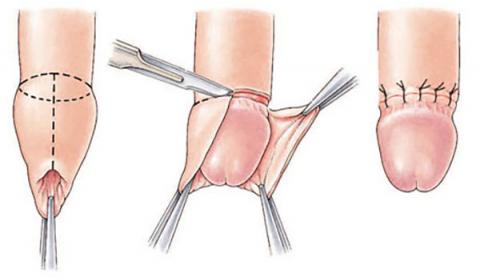What is a circumcision?
This is an operation to remove the prepuce or foreskin (the fold of soft skin which covers the head of the penis).
Who might need a circumcision?
Apart from social or religious reasons there are a number of situations when a circumcision might be recommended:
-
Phimosis – when the foreskin cannot be retracted fully allowing the head of the penis to be seen.
-
Balanitis – infection or inflammation of the head of the penis – especially if recurrent.
-
Paraphimosis – this occurs when the foreskin after being retracted over the head of the penis cannot be returned to its original position. This results in painful swelling of the head of the penis (glans).
-
Bleeding and / or pain during intercourse due to poor retraction. Some men experience pain on erection alone if the phimosis is severe.
-
If ballooning of the foreskin occurs during urination.
-
Suspicion of a growth or tumour on the penis.
Are there alternatives to circumcision?
-
Topical steroid creams can occasionally reverse a phimosis.
-
Dorsal slit – the foreskin is cut without removing any skin. It allows retraction but is cosmetically unappealing.
-
Frenuloplasty – the tight band of skin behind the head of the penis is divided – does not always solve the problem (<50% success if foreskin is still present).
What happens in a circumcision?

The operation is usually performed under a general anaesthetic. It is usually done as a day-case procedure, which means that you will be allowed home 3-4 hours after you have recovered from your general anaesthetic.
A circumferential incision is made just below the head of the penis. The foreskin is then retracted and assessed as to the amount of skin to be removed. After matching the appropriate areas the foreskin is removed, any bleeding stopped and the skin edges closed with dissolving stiches.
After the procedure
For a few days after your procedure, it is normal to experience any of the following:
-
Some discomfort in the head of the penis (glans).
-
Some mild bruising and swelling around the wound.
All usually settle quite rapidly without the need for any treatment.
What can you do to help?
-
Use a cold pack on the penis for 30 minutes every 4 hours for the first 24 hours after your procedure if it feels swollen.
-
2 Panadol every 4 hours.
-
Wear 2 pairs of firm jockey underwear – especially when walking about.
-
Avoid heavy lifting and overactive sports that put you at risk of getting “a knock”.
Do not be concerned if you get an erection, however do NOT take things any further!
Side Effects
Most procedures are straightforward; however as with any surgical procedure there is a chance of side effects or complications. There are no common side effects from circumcision apart from discomfort in the immediate post-operative period.
Occasional
-
Peeling of the skin of the glans (head of the penis) – a bit like sunburn without the pain. Settles quite rapidly.
Rare
-
Bleeding from the wound occasionally needing a further procedure.
-
Wound infection that requires antibiotics.
-
Scar tenderness, rarely long term.
-
Being unhappy about the appearance of the penis.
-
Need for removal of excess skin at later date.
-
A biopsy of abnormal area on glans if cancer a concern.
